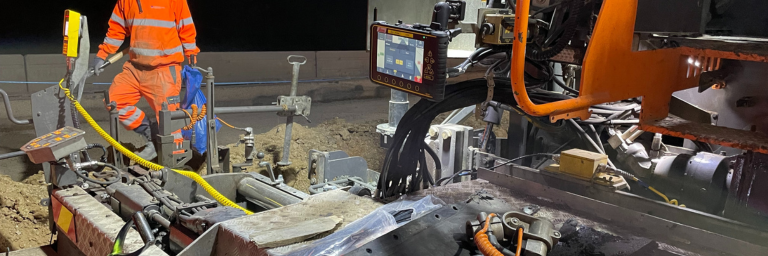Alliance with Leica Geosystems brings digitalisation to road laying on A12 in Essex
Product: 14,900 tonnes of cement bound granular material (CBGM) for the subbase plus 17,500 tonnes of asphalt for the base, binder and surface courses all laid using 3D machine control technology
Main contractor: Morgan Sindall
Client: National Highways
Overview: Heidelberg Materials and Leica Geosystems, part of Hexagon, worked together to improve the efficiency, accuracy and safety of the road laying on the A12 Margaretting Bypass in Essex, part of National Highways’ Concrete Renewal Scheme, using 3D machine control technology.
Project description: Heidelberg Materials Contracting and Leica Geosystems are working together to improve road construction and maintenance safety, quality and efficiency using the latest technology.
Since forming a strategic alliance two years ago, the companies have been sharing knowledge and experience to enhance the adoption of modern road construction methods and create a connected and autonomous construction site in line with the DfT’s approach to digital technology in construction.
As a result, Heidelberg Materials Contracting has integrated Leica Geosystems’ 3D machine control solution to its pavers to ensure a right first-time approach to road laying. The system is designed to make paving easier and more cost effective by improving efficiency, accuracy and provides a heightened emphasis on safety.
The solution uses precise measuring instruments called total stations, which continuously send positioning information to the 3D machine control system. Using this data in real-time, the Leica MC1 solution can position the paver to the 3D design model and give necessary corrections to achieve the client’s tolerances.
This eliminates inaccuracies that can result from using pins and stringlines, delivering a consistent height and ensuring an extremely smooth finish, as well as improving productivity and on-site safety by reducing the number of manual interventions. The software also provides real-time visibility of progress.
The importance of smooth road surfaces is well documented. As well as reducing the likelihood of damage to vehicles and causing accidents and injury to vulnerable road users, they cut journey times, improve ride quality, reduce fuel consumption (cutting vehicle emissions), and reduce noise.
Extensive testing of the system took place before the technology was used for the first time on the A12 Margaretting Bypass in Essex, part of National Highways’ Concrete Renewal Scheme.
The work saw the removal and replacement of the previous concrete road surface between junctions 13 (Ingatestone) and 15 (Webb’s Farm Interchange/Three Mile Hill) with a recycled materials base and an asphalt surface. The project was carried out through main contractor Morgan Sindall on behalf National Highways.
Using the technology on the A12 Margaretting Bypass removed the need for traditional laying methods using pins, significantly reducing the people plant interface in a tight working environment while improving efficiency.
It allowed Morgan Sindall to deliver the project faster and more accurately than normally expected, ensuring that each layer of new asphalt surface was laid safely and at the correct level, meeting National Highways’ smoother roads criteria.
Key benefits of using 3D machine control system:
Safety – reduces the number of manual interventions
Efficiency – improves onsite productivity
Accuracy – ensures a consistent height
Quality – delivers an extremely smooth finish, promoting fuel efficiency

